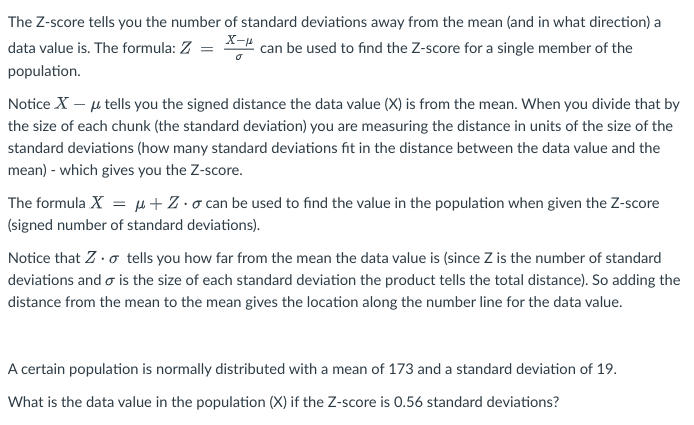The Z-score tells you the number of standard deviations away from the mean (and in what direction) a data value is. The formula: Z = X can be used to find the Z-score for a single member of the population. Notice X - μ tells you the signed distance the data value (X) is from the mean. When you divide that the size of each chunk (the standard deviation) you are measuring the distance in units of the size of th standard deviations (how many standard deviations fit in the distance between the data value and the mean) - which gives you the Z-score. The formula X = μ + Zo can be used to find the value in the population when given the Z-score (signed number of standard deviations). Notice that Z. o tells you how far from the mean the data value is (since Z is the number of standard. deviations and is the size of each standard deviation the product tells the total distance). So adding t distance from the mean to the mean gives the location along the number line for the data value.
The Z-score tells you the number of standard deviations away from the mean (and in what direction) a data value is. The formula: Z = X can be used to find the Z-score for a single member of the population. Notice X - μ tells you the signed distance the data value (X) is from the mean. When you divide that the size of each chunk (the standard deviation) you are measuring the distance in units of the size of th standard deviations (how many standard deviations fit in the distance between the data value and the mean) - which gives you the Z-score. The formula X = μ + Zo can be used to find the value in the population when given the Z-score (signed number of standard deviations). Notice that Z. o tells you how far from the mean the data value is (since Z is the number of standard. deviations and is the size of each standard deviation the product tells the total distance). So adding t distance from the mean to the mean gives the location along the number line for the data value.
Glencoe Algebra 1, Student Edition, 9780079039897, 0079039898, 2018
18th Edition
ISBN:9780079039897
Author:Carter
Publisher:Carter
Chapter10: Statistics
Section10.3: Measures Of Spread
Problem 26PFA
Related questions
Question

Transcribed Image Text:The Z-score tells you the number of standard deviations away from the mean (and in what direction) a
data value is. The formula: Z = X can be used to find the Z-score for a single member of the
population.
Notice X - μ tells you the signed distance the data value (X) is from the mean. When you divide that by
the size of each chunk (the standard deviation) you are measuring the distance in units of the size of the
standard deviations (how many standard deviations fit in the distance between the data value and the
mean) - which gives you the Z-score.
The formula X = μ+Z-o can be used to find the value in the population when given the Z-score
(signed number of standard deviations).
Notice that Z. tells you how far from the mean the data value is (since Z is the number of standard
deviations and is the size of each standard deviation the product tells the total distance). So adding the
distance from the mean to the mean gives the location along the number line for the data value.
A certain population is normally distributed with a mean of 173 and a standard deviation of 19.
What is the data value in the population (X) if the Z-score is 0.56 standard deviations?
Expert Solution
This question has been solved!
Explore an expertly crafted, step-by-step solution for a thorough understanding of key concepts.
Step by step
Solved in 2 steps

Recommended textbooks for you

Glencoe Algebra 1, Student Edition, 9780079039897…
Algebra
ISBN:
9780079039897
Author:
Carter
Publisher:
McGraw Hill

Glencoe Algebra 1, Student Edition, 9780079039897…
Algebra
ISBN:
9780079039897
Author:
Carter
Publisher:
McGraw Hill